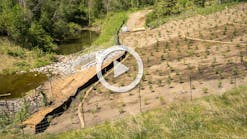A Fallen Tree Makes a Splash
No one knows when it happened: some would say perhaps it made no sound, or maybe no one was listening, but something changed in the watershed upstream of several properties in a Noblesville, IN, subdivision. Suddenly, the slope of a streambank in a neighborhood backyard began wasting away.
When Hamilton County Soil and Water Conservation district administrator Ginger Davis came to town to give a Master Naturalist presentation, the couple whose backyard had been affected by the uptick in erosion paid particular attention. They asked Davis to follow up with a visit to their home to try to figure out what was eating away at their property line at the edge of the creek, and how to fix it. “One of our goals is to provide technical assistance to our landowners,” says Davis. The homeowner explained that because of the rugged terrain in the backyard and mobility issues, she had been unable to venture to the bottom of the steep slope to evaluate the extent of the damage firsthand. “I went to look at their situation,” says Davis.
The home had been constructed on the bluff overlooking a deep ravine. At the floor of the chasm ran a seasonal creek largely fed by stormwater. The homeowner explained to Davis that her husband had climbed into the ravine several times, attempting to place stones to stem the sudden tide of erosion, but it didn’t seem to help. When Davis told her that what they had been able to see for themselves from their vantage point on the precipice of the bluff was just a minor part of a much bigger problem, she was stunned. Upon closer examination, it became evident that the creek was beginning to undermine and undercut the lot itself, potentially transforming the sloping ravine into a 20-foot cliff.
Davis noted that the creek originated just a short block away, emerging from a conduit at a stormwater outfall. Every time it rained, stormwater barreled out into the creek, tearing away soil and rock. The erosion had become so severe that if left untreated, it would potentially threaten the integrity of the family’s tool shed situated not far from the crest of the ravine.
According to Davis, it was difficult to pinpoint any particular cause for such a drastic change in the volume of stream flow. Nonetheless, she could safely rule out new construction or increased impermeable surface in the upland watershed, observing that there had not been any recent development or significant construction going on in the watershed for some time. The change in hydrology, she believed, was probably initiated “by a tree falling somewhere up in the watershed and redirecting the water” to this outfall upstream of the residential drive. Davis suspected, in addition, that there might have been a spring higher up in the watershed that was adding moisture to the streamflow. At any rate, as it appeared that the increased volume in stormwater could be attributed to natural causes, it became clear that it would not be possible to stem the erosion by addressing the cause at its source.
Considering All Options
Davis recommended that the homeowners consider onsite erosion control measures to protect their property, sharing a few potentially helpful design concepts with them. “We provided examples of different backyard streambank protections along with lists of vendors who could perform the work. But we are unbiased. I always encourage landowners to take in all ideas.”
Pomme de Terre Lake in Minnesota
Perched on the hilltop with the creek traversing 50 yards across the property’s boundary line, the homeowner muses, “We’ve got quite a panorama.” She recalls, “We had various contractors come out. Some wanted to put in riprap, some wanted to put in A-Jacks. There were just as many different ideas as there were contractors who came out and looked.” Summarizing her preference for softer solutions, she says, “We wanted something to blend in with this beautiful natural environment.” Although Davis notes that hard armoring can provide significant protection, she adds, “If you can use a softer approach and get vegetative growth established, that vegetative growth can act as an armor as well.”
The homeowner got the picture. “Just putting dirt down there would not be the answer; it would just erode away. We were afraid riprap would not be attractive, and it could erode, too, because you have to fill it in with dirt and the dirt could wash away.” She adds, “When Hoosier Aquatic came out, they talked about the most natural solution.
“Mother Nature had already excavated it; they needed to build it back up. From everything we heard, building it back up vis-a-vis soil tubes or coir logs and planting native growth was the best way to do it because that was a long-term answer.”
Soil Tubes for a Natural Effect
The homeowners selected Hoosier Aquatic Management to restore the bank based on the company’s natural approach, called Living Logs. “They brought in fabric tubes and filled them with soil, and because we are on the edge of the ravine, they were just able to drop them down into the ravine from the edge of the driveway.”
The soil-filled tubes were staked in at the bottom of the ravine where soil loss was most severe. Coir logs were placed at the top of the installation, and an erosion control blanket was stapled in place, covering the restoration to protect the slope. Hydromulch was applied over the blankets, soil tubes, and slope to encourage speedy vegetative growth. Hoosier Aquatic also pulled out invasive honeysuckle to promote the viability of the native plantings.
The homeowner credits Hamilton County Soil and Water Conservation with helping formulate a solution that offered the best chance of preserving the natural beauty of the landscape. “Ginger was definitely instrumental in telling us what was going on and sent us tons of material to read,” she says.
The erosion blankets covering most of the area and coir logs tucked into the top of the eroded area have been defending the hillside. After two weeks and a heavy rain, the project was holding up and plants were growing. Consulting her husband, who had been down to inspect the restoration, the homeowner notes, “It’s by no means green, but it’s starting to grow.”
She adds, “This route, to us, was the most environmentally friendly one.” In addition, the homeowners were able to take advantage of a grant from the Backyard Conservation program based on the critical area treatment criteria. “So we will get back a check for $2,000,” says the homeowner.
An Icy Wind
Pomme de Terre Lake in Minnesota makes an attractive ice fishing destination during the colder months of the year. During the warmer season, when the ice has melted away, the lakefront becomes a destination for weddings, retreats, and vacation getaways. The Pomme de Terre Lodge (now West Pomme Lodge) occupies the perfect site for those summertime festivities. However, between those two seasons, occasionally something unusual happens, says Matt Solemsaas, district administrator for the Stevens Soil and Water Conservation District. When the surface of the lake is frozen solid and the water doesn’t move, erosion is at a minimum, but at the end of a severe winter, temperatures can fluctuate wildly, sometimes giving rise to rapidly warming conditions in early spring. During these sudden warm spells, he explains, ice on the lake breaks up into massive chunks that can roll atop wind-tossed waves. The blocks of ice can be impelled onshore where they cut a swath across the land that, he says, leaves virtually no stone unturned. In a strong wind, the ice can crawl up onto the beaches and stalk over the shore, even forcing its way into residential cabins and lakeshore cottages. When it finally melts away, it leaves behind a trail of scoured and eroded shoreline.
During the average year, however, Pomme de Terre Lake is an attractive location year-round. “Stevens County doesn’t have a lot of lakefront property. The lake is the main recreation location but also is the site of year-round residences,” says Solemsaas. “It has a big economic impact for the county—attractive as a sport fishing site in summer and for ice fishing in the winter.” Through the year, the lodge is a focal point for many of the festivities.
“Erosion is a problem in different spots, but it’s a fairly flat shoreline,” he says. “However, one area around the Pomme de Terre Lodge has a bit more steepness that makes it more susceptible to erosion.” According to Solemsaas, the owners of the lodge noticed that a section of the shoreline was degrading and brought the problem to the attention of the Soil and Water Conservation District. “We identified the problem and told the landowners about their options.” Solemsaas also explained to the owners that the district had cost-share opportunities available as well, supported by the Clean Water Fund financed by a 3/8 of 1% legacy tax on all purchases. “They said, ‘Go for it.’ So we got in touch with a lakeshore specialist and put together a design.”
That initial design called for a natural approach to repairing the 300-foot stretch of damaged shoreline. The edge of the shore was reinforced with coir logs. Topsoil was placed behind that, and the top of the bank was given a natural treatment. “They wanted native vegetation, so we planted 5,000 plugs in the coir logs and reinforced the turf with some heavy-duty coconut matting. It looked really nice, with a real gradual slope, which was what they were looking for. This was done in the summer. It was fine all through the winter. We didn’t have a lot of moisture that year. Came back in the spring; it was still looking good,” says Solemsaas.
Things changed drastically, though, when a warm spell in early spring led to a quick breakup of the ice covering the lake. Then came the scenario the lodge owners most dreaded: wind squalls coming in from over the lake sent the ice surging toward the shore. “The ice was coming off and we got very high winds one day coming straight from the east, and it ended up just tearing up the restoration. It was still very new; it had hardly any chance to grow. So, back to the drawing board.”
Solemsaas says the engineers concluded that “softer designs would not be sufficient to hold that area when facing potential ice heaves.” They decided the shoreline would require somewhat heavier armoring than could be provided by coir logs. Following the revised design, contractors placed rock riprap along the entire 300-foot project site. However, Solemsaas says, the plan was still to back up the stone with native plantings to give the area as natural a look as possible.
Vicky Dodsall, president of Lawn and Driveway Service Inc., the firm that performed repairs to the installation, says the erosion damage was clearly visible along the edge of the shore when she first surveyed the site at the start of the project. Contractors trucked in topsoil and graded the slope to rebuild the shoreline. Riprap was placed at the toe to provide armoring in case of a repeat of the ice heaving incident. Then, Lawn and Driveway technicians prepped the soil and seeded with a native grass mix. They reinforced the turf, placing a wood-fiber blanket from Western Excelsior over the seeded area and stapling it in. Western Excelsior 12-inch coir logs were brought in and staked in at the point where the blanket met the existing turf. “The native grasses will grow through the blanket and have a deeper root structure than typical turf grasses,” which will help reduce erosion, says Dodsall.
Solemsaas says the native plantings at the top of the bank that had survived the ice floes were healthy enough to be left in place. The Western Excelsior coir logs in front of them hold down the mat and provide the backbone and the muscle for the shorefront restoration. “They are very heavy, and once they get wet they are really, really heavy. They act as a weight.” He notes that the logs from Western Excelsior “are pretty tough. You have to use a pretty significant sledgehammer to pound the stakes into them to hold them down.”
Dodsall says she also appreciates the consistent quality of Western Excelsior’s coir logs. “They have a nice round log; the consistency is good; there are no voids. I like working with them. The log is going to filter out a lot of sediments when there’s a runoff issue.”
According to Solemsaas, compared to the previous design, the repaired installation has held up well over the course of two recent winters. “Now with the rock in there, it’s holding quite nicely,” he says. “We planted plugs in the logs at the direction of shoreline experts. They are designed to stay there and become part of the shoreline.”
He adds, “The owners are happy with it. It’s not as natural as the original plan, but it is not used as a beach; they have beachfront in other areas.” Solemsaas still marvels at the power of windblown ice. “You can see videos of it taken in places like Giant Lake, with blowing ice just coming up and going into people’s cabins. It wasn’t quite to that effect here, but it heaves up, and it’s pretty powerful stuff.” He notes, “We haven’t had any comparable situations with repeats of ice floes, but I would be pretty confident, with the rock there, that it would hold.”
Sustainable Sediment Control
Jason Fraker, president of JNR Equipment & Erosion Services in Meshoppen, PA, said he’s been able to handle a wide variety of projects, from small contracts to large power substations, using Filtrexx SiltSoxx compost-filled filter socks for erosion and sediment control. There is a big difference, he notes, between wattles and compost-filled socks. “We use the wattles as a temporary installation where we put mats or something and there are going to be tracks going through and you’ve got to remove them daily. A wattle really replaces a hay bale, which is good for a temporary diversion of water.” In contrast, he says, “a compost filter sock is more long-term and is for sediment removal.”
Britt Faucette, director of Research and Technical Services for Filtrexx International, says that in addition to their performance and versatility onsite, SiltSoxx are gaining popularity because of a growing awareness of the importance of sustainable management practices. He believes what helps make SiltSoxx attractive to customers is that “they are significantly more environmentally sustainable in a variety of ways” when compared to wattles or silt fences for sediment control. These benefits extend beyond the immediate project site. According to Faucette, using compost sourced locally helps keep excess organic waste out of the landfill, helping to sequester carbon and reduce the landfill’s potential methane gas production rate. Instead, the composted materials can be used to enhance the environment. As Faucette explains, the majority of projects do not remove the compost-filled SiltSoxx at the end of the project, but rather cut them open, spreading the compost across the landscape. Added to the existing soil, it can serve as a growth medium for plants, which in turn capture and sequester carbon from the atmosphere. Furthermore, he notes, the compost absorbs a lot of moisture and improves soil structure, thereby conserving water from irrigation and reducing stormwater runoff well into the future. “By using these compost-based sustainable management practices, we restore natural water and carbon cycles, working with nature in sediment control, rather than against nature.”
Fraker appreciates the socks’ ease of use. Compared to silt fences, he says, compost-filled SiltSoxx have a lower life cycle cost. However, he concedes that filter sock installations do require some maintenance. “After a heavy rainfall, you have to come inspect them and remove the sediment,” but with the silt fence, there is even more labor involved. When dealing with a silt fence, he says, “even if it’s installed right, it gets a lot of sediment. Then it doesn’t filter, so you get ponding water that can cause the fence to blow out.” Wattles, he points out, “are really not designed to stop a mass flow of water.” In his view, the compost-filled socks are much more versatile than either. “You can put compost filter socks in that will divert the water down to a sediment trap built from filter socks stacked on top of each other in pyramid fashion, so that they act as a wall that is actually designed to filter a mass quantity of water.”
Fraker says the most common error people make when trying to set up compost filter socks as a sediment trap is failing to install them on contour. “If you don’t install it level, all of your water will rush down to that low spot, and it’s not designed for that mass flow of water. It can cause [the stack] to topple over. It’s designed to be on contour, so the water naturally pushes through it and filters out the back side.”
A tip Faucette offers is to make sure the ground surface is smooth and the bottom of the sock is in contact with the ground. But, he says, unlike with straw wattles and silt fences, there is no requirement to trench in Filtrexx SiltSoxx.
Fraker believes good technique is the key to a successful application of the system. “If it’s for a sediment trap, where they are stacked, we’ll bring out a laser—like when you put in a pad and level it for a house. You can move it around to make sure it’s level. Because there’s no digging involved with a filter sock compared to a silt fence, you don’t have to worry so much about rocks and what’s underneath it.”
“The compost media is sourced regionally from organics recycling manufacturers,” says Faucette. “We partner with a third-party laboratory to test and certify compost filter media from each location on a regular basis, utilizing only federally approved test methods, and to ensure compliance with all jurisdictional state and federal specifications. We are the only organization in the industry that does this.”
Fraker believes it’s a reliable system. “The netting on the outside has a life of six months, nine months, or a year, depending on which grade you use, and then it just naturally degrades and you’re left with a pile of compost that trees or plants grow out of. You choose the grade based on the length of the project—usually, the engineer will determine what grade is needed and we go from there.” In addition to photodegradable polypropylene fiber socks, which Fraker says he uses frequently on long-term projects, Filtrexx also offers natural-fiber biodegradable socks.
The SiltSoxx can’t be compared one-to-one with silt fence, says Faucette, because flow-through rates are greater for SiltSoxx—typically they can handle twice the drainage area, or need to be only half the height of silt fence—but making the switch is relatively easy, and they can be used in a complementary fashion.
Fraker suggests that in hilly areas it can be an effective strategy to install silt fence as part of a combined erosion control and sediment filtration system along with SiltSoxx. On tall steep slopes, he often uses the socks along with a super silt fence, which he describes as a chain-link fence providing support and structure for a geosynthetic fabric. “We’ll put the super silt fence at the bottom of a hill if there’s going to be any chance of boulders, rocks, or really heavy concentrated water flow coming down, because it will catch everything, and often we’ll put socks in front of that to filter the water,” he says.
“I’ve seen the stuff work. If it’s designed properly and installed properly, it works great compared to any other product I’ve seen, because it actually filters the water instead of blocking the water. It’s a filter so it lets the water flow through it. It works just like it’s supposed to as long as it’s done correctly,” he says of the socks.
Erosion is always ready and waiting for a weakness it can exploit. Sometimes it finds its chance falling silently in the woods. Sometimes it finds an opening among waves crashing ashore. For whatever the cause, coir logs, soil tubes, and compost-filled filter socks offer solutions to fill the gaps.








